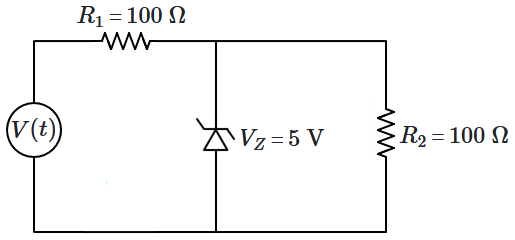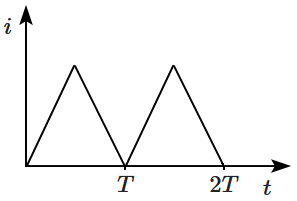Select Chapter Topics:
Zener diode is not used for:
1.
oscillatory circuit
2.
current amplification
3.
voltage amplification
4.
all of the above
Subtopic: Applications of PN junction |
69%
Level 2: 60%+
Hints
The two inputs \((A)\) and \((B)\) of a logic circuit are shown along with the output \((Y)\) as functions of time. The 'highs' represent logic \(1\) and the 'lows' represents logic \(0.\) The correct truth table for this circuit is:


| 1. |
|
2. |
|
||||||||||||||||||||||||||||||
| 3. |
|
4. |
|
Subtopic: Logic gates |
80%
Level 1: 80%+
Hints
For a Zener diode used as a voltage regulator, the connections are as follows:
Choose the correct option from the options given below:
| (I) | In forward bias |
| (II) | In reverse bias |
| (III) | In parallel with the load |
| (IV) | In series with the load |
Choose the correct option from the options given below:
| 1. | (I) and (II) only |
| 2. | (II) and (III) only |
| 3. | only (I) |
| 4. | only (IV) |
Subtopic: Applications of PN junction |
87%
Level 1: 80%+
Hints
Unlock IMPORTANT QUESTION
This question was bookmarked by 5 NEET 2025 toppers during their NEETprep journey. Get Target Batch to see this question.
✨ Perfect for quick revision & accuracy boost
Buy Target Batch
Access all premium questions instantly
The current-voltage characteristic of an ideal \(\mathrm{p \text{-}n}\) junction diode is given by the graph as shown in the following figure:

This diode is connected with a resistance of \(5~\Omega\) in series with it as shown below:

Which of the following shows the dependence of the voltage \(V_{AB}\) and the current \(i,\) when the diode is forward-biased?
(\(V_{AB}\) in volt, \(i\) in ampere)

This diode is connected with a resistance of \(5~\Omega\) in series with it as shown below:

Which of the following shows the dependence of the voltage \(V_{AB}\) and the current \(i,\) when the diode is forward-biased?
(\(V_{AB}\) in volt, \(i\) in ampere)
| 1. | \(V_{A B}=i\cdot5+0.6\) |
| 2. | \(V_{A B}=i\cdot5-0.6\) |
| 3. | \(V_{A B}=i\cdot5+(0.6-5)\) |
| 4. | \(V_{A B}=i\cdot5+\left(0.6+5\right)\) |
Subtopic: PN junction |
Level 3: 35%-60%
Hints
The voltage \(V_{AB}=20~\text{V}\) at its peak value, and is sinusoidal in time. The current \(i\) (in amperes), when plotted as a function of time, is given by:
(consider the diodes as ideal.)

(consider the diodes as ideal.)

| 1. |  |
2. |  |
| 3. |  |
4. |  |
Subtopic: PN junction |
Level 3: 35%-60%
Hints

For the above circuit, the applied voltage \(V(t)\) is periodic and linear, and is shown by the waveform below:

The current flowing through \(R_2\) varies as:
| 1. |  |
2. |  |
| 3. |  |
4. |  |
Subtopic: PN junction |
57%
Level 3: 35%-60%
Hints
Given below are two statements:
| Assertion (A): | The resistance of a photodiode decreases when light having photons of sufficient energy is incident on it. |
| Reason (R): | When energetic photons fall on the \(\mathrm{p\text{-}n}\) junction of a photodiode, electron-hole pairs are created due to the breaking of the valence bonds. |
| 1. | (A) is True but (R) is False. |
| 2. | (A) is False but (R) is True. |
| 3. | Both (A) and (R) are True and (R) is the correct explanation of (A). |
| 4. | Both (A) and (R) are True but (R) is not the correct explanation of (A). |
Subtopic: Applications of PN junction |
73%
Level 2: 60%+
Hints
In the circuit shown in the diagram given below, \(R\) is a small resistor, \(V_i\) is the input voltage between \(A\) & \(B\) while \(V_o\) is the output voltage between \(C\) & \(D\).

Consider the following two statements and mark the correct option.

Consider the following two statements and mark the correct option.
| (I) | \(\text{If}~V_i>2~\text{V}, ~\text{then}~V_o = V_i\) |
| (II) | \(\text{If}~V_i<2~\text{V}, ~\text{then}~V_o = 2~\text{V}\) |
| 1. | (I) is True. |
| 2. | (II) is True. |
| 3. | (I) and (II) are both True. |
| 4. | (I) and (II) are both False. |
Subtopic: PN junction |
Level 3: 35%-60%
Hints
The dynamic resistance of a diode is given by; \(R=\dfrac{26}{i(\text{mA})}~\Omega,\) where \(i\) is the diode current.
| Statement I: | If the current through the diode increases, then the dynamic resistance decreases. |
| Statement II: | If the temperature of the diode is increased, with the potential difference fixed, the dynamic resistance decreases. |
| 1. | Statement I is incorrect and Statement II is correct. |
| 2. | Both Statement I and Statement II are correct. |
| 3. | Both Statement I and Statement II are incorrect. |
| 4. | Statement I is correct and Statement II is incorrect. |
Subtopic: PN junction |
73%
Level 2: 60%+
Hints
In the following figure, the diodes which are forward biased are:
| (a) |  |
| (b) |  |
| (c) |  |
| (d) |  |
1. (a), (b) and (d)
2. (c) only
3. (a) and (c)
4. (b) and (d)
Subtopic: PN junction |
86%
Level 1: 80%+
AIPMT - 2011
Hints






